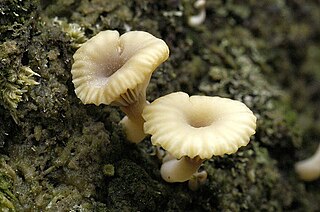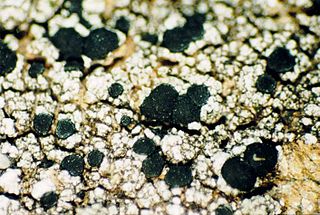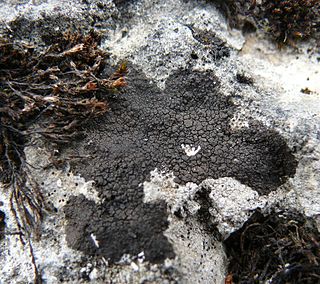
A lichen is a composite organism that arises from algae or cyanobacteria living among filaments of multiple fungi species in a mutualistic relationship. Lichens have properties different from those of their component organisms. They come in many colors, sizes, and forms and are sometimes plant-like, but are not plants. They may have tiny, leafless branches (fruticose); flat leaf-like structures (foliose); grow crust-like, adhering tightly to a surface (substrate) like a thick coat of paint (crustose); have a powder-like appearance (leprose); or other growth forms.

Cladonia is a genus of moss-like lichens in the family Cladoniaceae. They are the primary food source for reindeer/caribou. Cladonia species are of economic importance to reindeer-herders, such as the Sami in Scandinavia or the Nenets in Russia. Antibiotic compounds are extracted from some species to create antibiotic cream. The light green species Cladonia stellaris is used in flower decorations.

The Cladoniaceae are a family of lichenized fungi in the order Lecanorales. It is one of the largest families of lichen-forming fungi, with about 560 species distributed amongst 17 genera. The reindeer moss and cup lichens (Cladonia) belong to this family. The latter genus, which comprises about 500 species, forms a major part of the diet of large mammals in taiga and tundra ecosystems. Many Cladoniaceae lichens grow on soil, but other can use decaying wood, tree trunks, and, in a few instances, rocks as their substrate. They grow in places with high humidity, and cannot tolerate aridity.

Erik Acharius was a Swedish botanist who pioneered the taxonomy of lichens and is known as the "father of lichenology." Acharius was famously the last pupil of Carl Linnaeus.

Usnea is a genus of mostly pale grayish-green fruticose lichens that grow like leafless mini-shrubs or tassels anchored on bark or twigs. The genus is in the family Parmeliaceae. It grows all over the world. Members of the genus are commonly called old man's beard, beard lichen, or beard moss.

The Parmeliaceae is a large and diverse family of Lecanoromycetes. With over 2700 species in 71 genera, it is the largest family of lichen-forming fungi. The most speciose genera in the family are the well-known groups: Xanthoparmelia, Usnea, Parmotrema, and Hypotrachyna.

The Leotiomycetes are a class of ascomycete fungi. Many of them cause serious plant diseases.

Basidiolichens are lichenized members of the Basidiomycota, a much smaller group of lichens than the far more common ascolichens in the Ascomycota. In arctic, alpine, and temperate forests, the most common basidiolichens are in the agaric genus Lichenomphalia and the clavarioid genus Multiclavula. Several lichenized genera occur in tropical regions, the most common being the foliose Dictyonema. Previously basidiolichens had been classified in their own subclass, Basidiolichenes. Molecular based phylogeny does not support classification of the genera together.

The Lecanoraceae are a family of lichenized fungi in the order Lecanorales. Species of this family have a widespread distribution.

The Verrucariaceae are a family of mostly lichenised fungi in the order Verrucariales. The lichen-forming species have a wide variety of thallus forms, and include crustose (crust-like), foliose (bushy), and squamulose (scaly) representatives. There are several dozen lichenicolous (lichen-dwelling) examples in the family, and some genera that contain solely lichenicolous members. An unusually wide variety of photobiont partners have been recorded, mostly green algae, but also brown algae and yellow-green algae. The family, circumscribed nearly two centuries ago, now includes 56 genera and over one thousand species. Most diversity occurring in the temperate climates of the Northern Hemisphere. Rocks and soil are the most common substrates for the Verrucariaceae, with growth on wood and bark less common. Some semi-aquatic lichens occur in this family, including about two dozen species of marine lichens.

Caloplaca is a lichen genus comprising a number of distinct species. Members of the genus are commonly called firedot lichen, jewel lichen. gold lichens, "orange lichens", but they are not always orange, as in the case of C. albovariegata. The distribution of this lichen genus is worldwide, extending from Antarctica to the high Arctic. It includes a portion of northern North America and the Russian High Arctic. There are about thirty species of Caloplaca in the flora of the British Isles. An example species in this genus is Caloplaca saxicola, a lichen with worldwide distribution including the Antarctic continent, Europe and northern North America including the northern reaches of the Canadian boreal forests.

Lecanora is a genus of lichen commonly called rim lichens. Lichens in the genus Squamarina are also called rim lichens. Members of the genus have roughly circular fruiting discs (apothecia) with rims that have photosynthetic tissue similar to that of the nonfruiting part of the lichen body (thallus). Other lichens with apothecia having margins made of thallus-like tissue are called lecanorine.

Parmotrema is a genus of lichen belonging to the family Parmeliaceae. It is a large genus, containing an estimated 300 species, with a centre of diversity in subtropical regions of South America and the Pacific Islands.

Xanthoparmelia is a genus of foliose lichen in the family Parmeliaceae. Xanthoparmelia is synonymous with Almbornia, Neofuscelia, Chondropsis, Namakwa, Paraparmelia, and Xanthomaculina. This genus of lichen is commonly found in the United States, as well as Australia, New Zealand and Ecuador.
André Aptroot is a Dutch mycologist and lichenologist.

Crustose lichens are lichens that form a crust which strongly adheres to the substrate, making separation from the substrate impossible without destruction. The basic structure of crustose lichens consists of a cortex layer, an algal layer, and a medulla. The upper cortex layer is differentiated and is usually pigmented. The algal layer lies beneath the cortex. The medulla fastens the lichen to the substrate and is made up of fungal hyphae. The surface of crustose lichens is characterized by branching cracks that periodically close in response to climatic variations such as alternate wetting and drying regimes.
A corticolous lichen is a lichen that grows on bark. This is contrasted with lignicolous lichen, which grows on wood that has had the bark stripped from it, and saxicolous lichen, which grows on rock.
John Alan (Jack) Elix emeritus professor in chemistry at the Australian National University, is an organic chemist who has contributed in many fields: lichenology, lichen chemotaxonomy, plant physiology and biodiversity and natural product chemistry. He has authored 2282 species names, and 67 genera in the field of mycology.















